McCulloch J-2, G-ORVB / G-HEKY
McCulloch J-2, G-HEKY/G-ORVB, c/n 039, a small 2-seat autogyro, arrived at The Museum on 21st December 2008. Built in 1971 it was initially registered as N4329G in the United States. It was bought for the Bahrain Police in 1971 and operated there until withdrawn from service in 1981. Transferred to the UK, in 1981, it was bought from Everett Aero by Bob Bowles in 1989, registered as G-ORVB and was last flown in March 2002. In September 2007, it was acquired by Charles Watkinson, in Yorkshire, who re-registered it as G-HEKY but sold it to The Museum in November 2008. |
 McCulloch J-2 in 1991, registered as G-ORVB. |
|
The J-2 gyroplane, has a three-bladed rotor mounted above an enclosed cabin, stub wings, a fixed tricycle undercarriage and a horizontal stabiliser mounted on twin booms. A wooden pusher propeller, powered by a 180 hp Lycoming 0-360 engine, provides forward thrust. The J-2 was designed by Drago K.Jovanovich and first flew in June 1962. It went into quantity production in 1971, built by the McCulloch Aircraft Company in Lake Havasu City, Arizona. It had been planned that 600 machines per year would be built but only around 96 had been sold before production finally ceased in 1973. |
||
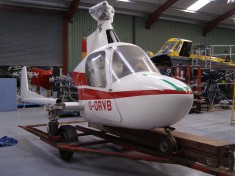 |
 |
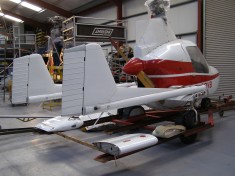 |
||
| G-ORVB in the Conservation Hangar on 27th December 2008. | After removal of one door panel and unpacking of blades and stub wings | A rear view showing that the horizontal stabiliser was missing. | ||
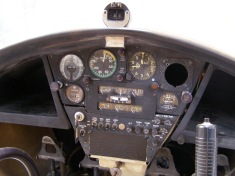 |
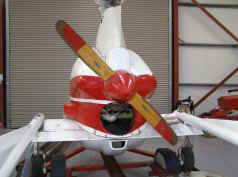 |
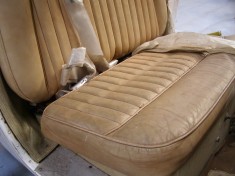 |
||
| The instrument panel appears to be complete except for radio and manifold pressure gauge. | The Sensenich two-bladed, fixed- pitch, wooden pusher propeller is mounted between the tail booms. | The comfortable bench seat hinges upwards for access to generous baggage space below. | ||

|

| |
| In March 2009 the stub wings, containing the fuel tanks, were fitted to G-ORVB and the newly-arrived horizontal stabiliser was installed. | ||
Jovanovich, McCulloch and the origins of the J-2 |
||||
|
The first tandem-rotor helicopter to be certified for commercial use in the United States was developed by the Helicopter Engineering Research Corporation between 1946 and 1950. Drago K.Jovanovich and Frank Kozloski, previously employed by Piasecki, had founded the Corporation, in Philadelphia, soon after the end of World War II. Their first machine remains one of the smallest helicopters to be built with tandem lifting rotors. The initial design was for a machine with contra-rotating, coaxial rotors but, persuaded by their design team, most of whom had also come from Piasecki, the tandem layout was adopted. The first prototype (N9000H), known as the JOV-3, was powered, initially, by a single 100hp Franklin piston engine belt-driving two tandem 3-blade rotors of 18.5 ft. diameter. A 125hp Lycoming O-290 engine replaced the Franklin subsequently. This prototype first flew in 1949 and its success led to a merger with the newly formed aircraft division of McCulloch Motors Corporation of Los Angeles and the development of the larger MC-4 (N4070K), with a 165hp Franklin 6V4-165-832 engine. This helicopter first flew, from Boulevard Airport, Philadelphia, in March 1951. Later in 1951 McCulloch started work on the slightly larger MC-4C, tandem rotor machine, fitted with a 200hp Franklin 6A4-200-C6 engine and twin egg-shaped fins on outriggers beneath the rear rotor. The US Army were interested in the MC-4C and ordered three examples, designated XH-30. The US Navy acquired a further two machines, designated XHUM-1 but neither service chose to order further machines. They were judged to be underpowered, with the rotor drive system seen as over-complex and unreliable. The design was certified for civilian use in February 1953 but no orders were placed. Probably as a result of these decisions, Jovanovich severed his liaison with McCulloch and formed the Jovair Corporation to further refine the MC-4C design. Three of the five military trial machines were returned to him. A few years of perseverance led to evolution of the MC-4C into a prototype 4-seat, 4-door, commercial helicopter known as the Jovair Sedan 4E, which received type approval from the FAA in 1963. Only two were built. A supercharged version, the Sedan 4ES, with a 225hp Franklin 6AS-335 piston engine, was also produced and an open tube framework variant was built as a trainer. A crop-spraying version was planned but never built. The Jovair Corporation did not have facilities to build the Sedan in quantity and no American manufacturer could be found to take up a licence. Jovanovich shipped one of the Sedan 4E machines to Europe, where a Swiss company seemed willing to enter a manufacturing agreement, but negotiations failed. It was reported, a few years ago, that this 40-year old machine had been found, abandoned but intact, in a Swiss warehouse and that attempts were to be made to restore it to flying condition. Back in America, Jovanovich sold the Sedan 4E design and assigned patent rights to the Hughes Tool Company, in Houston, Texas, The patents included some involving novel composite blade construction and fully articulated blade-to-hub connectors. Hughes Aircraft may have used some of these designs in the Hughes 269 helicopter development. Jovair, meanwhile, designed and built a small two-seat autogyro, which flew, for the first time, in June 1962. This machine,
the J-2 gyroplane, had a three-bladed rotor mounted above an
enclosed, side-by-side, two-seat cabin, stub wings, a tricycle undercarriage and a twin-boom
mounted tailplane. A single wooden pusher 2-blade propeller, powered by a 180hp Lycoming 0-360 piston engine, provided forward thrust. Jovanovich approached Bill
Lear (of Learjet fame) and Igor Bensen, for use of their production facilities but
McCulloch, eventually, purchased manufacturing rights and the J-2 was
certificated in May 1970. Aero Resources was established at Gardena, California, in 1974 and acquired the rights to manufacture the J-2. They offered an improved version, designated the 'Super J-2' (modifying the last examples off the McCulloch production line to this standard), but were unable to obtain enough orders to make production viable. These aircraft differed, primarily, in being fitted with a Hartzell variable pitch, 3-blade, metal propeller instead of the original Sensenich fixed pitch, 2-blade, wooden propeller. Several J-2s were still being flown, by enthusiasts, in 2004, two in Europe and ten in the United States. |